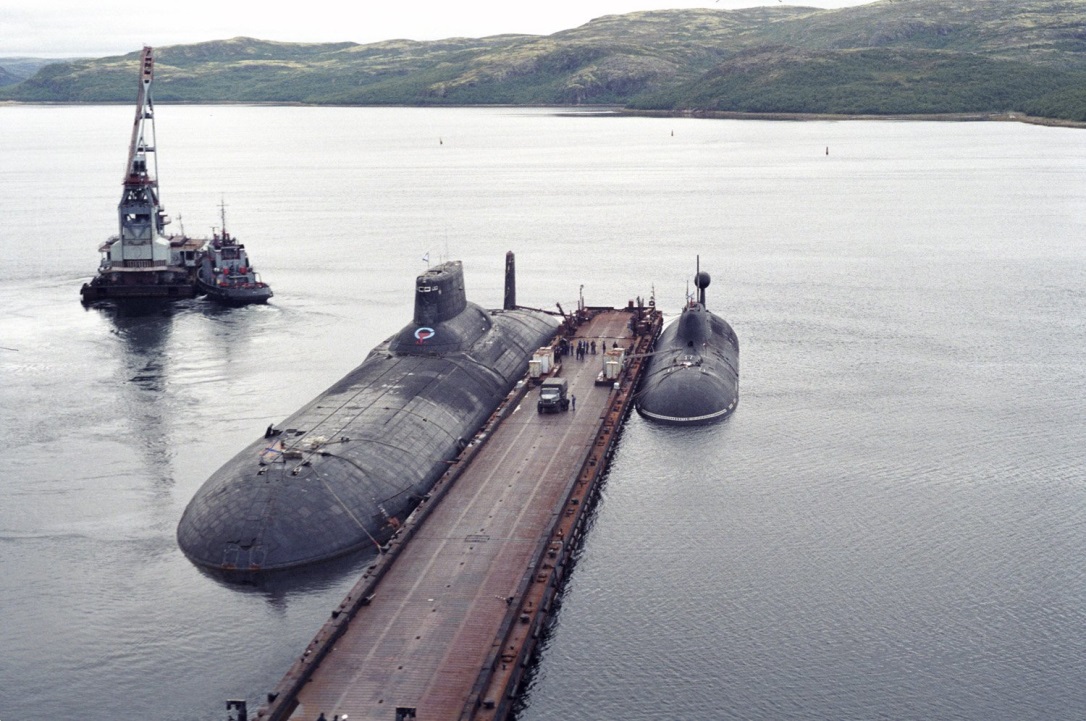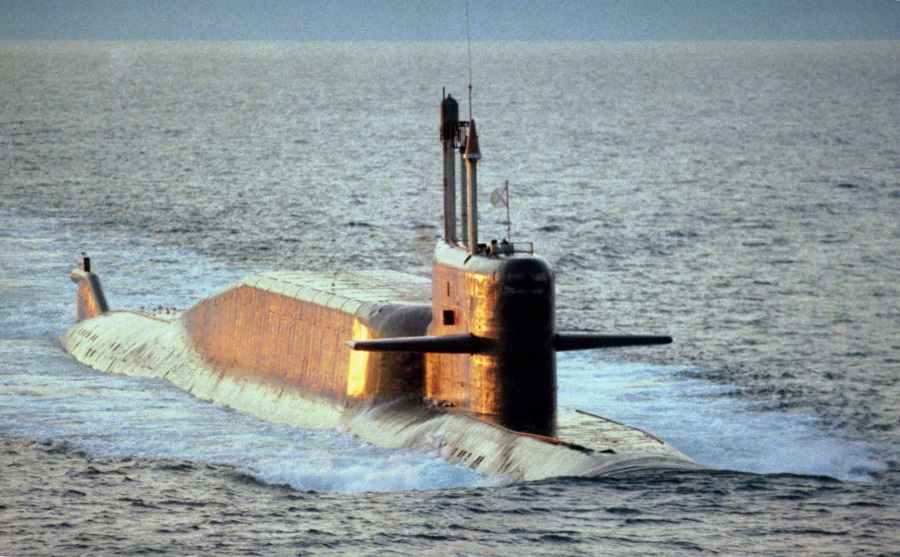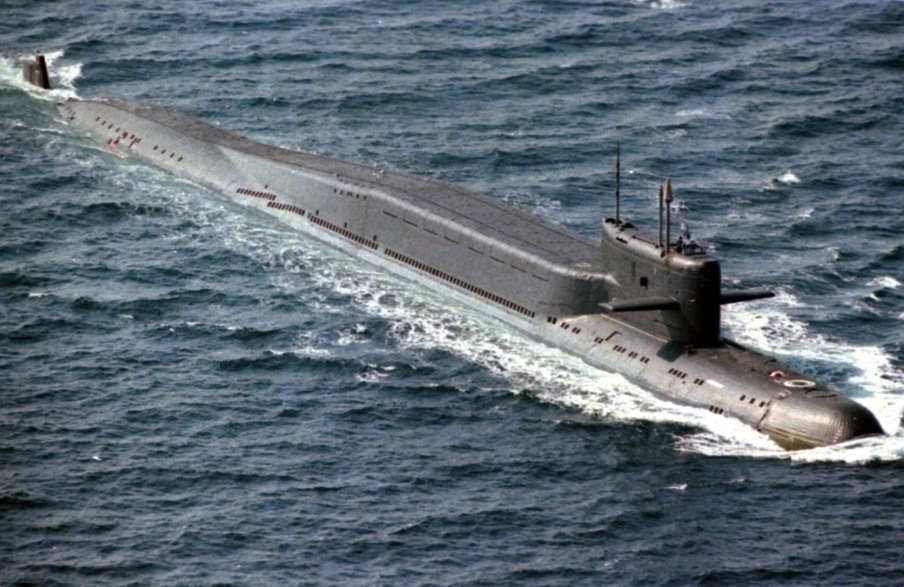Soviet SSBNs
During the late ‘80s and early ‘90s all of the older SSBNs of the Hotel and Yankee classes as well as the diesel powered Golf classes were scrapped (or in the case of five Yankee class – converted), 66 submarines in all. Although this mass scrapping ran counter to the Northern Fury trend of retention, it allowed the Soviet SSBN service to focus on modern, powerful units instead of frittering away resources on less useful /assets. The fleet that remained were 52 nuclear powered Ballistic Missile Submarines (SSBN) of two main classes (including four sub-classes of Delta SSBN). Although the venerable Delta I class is getting near the end of their useful life, they are still 10-15 years newer than many of the older veterans. The Soviets are attempting to maintain a balance with NATO which fields 38 American, six French and four British SSBNs but the NATO boats have a significantly higher potential warhead yield than the Soviet boats. Historically, two Delta IV and one Typhoon were under construction and scrapped in 1991, in Northern Fury they are launched and commissioned with more being built. At any time about 1/3rd of these boats will be on patrol, routinely the Delta class boats will deploy in two ‘Bastions’; one in the Barents Sea, and one in the Sea of Okhotsk, while the Typhoons will deploy further north to hide under the Arctic ice pack. This two pronged approach meant that all SSBNs could remain in relatively safe waters and not have to transit heavily contested zones such as the GIUK gap. At the commencement of Northern Fury 18 boats are deployed ad this raises to 22 in the first days of the war, flooding the SSBNs to sea would signal to the Americans that nuclear war is imminent and that is not the message that Moscow wants to send.
 These
massive submarines, called Akula or Shark in Russian, are the largest in
the world. They have a submerged displacement of 48,000 tons compared to
the next largest, the US Ohio class SSBN, of 18,750 tons, although the
two are about the same length (170-172 meters), the hull diameter of the
Typhoon is a massive 7.2 meters (23.6 feet). The main arsenal is the 20
R-39 Sturgeon SLBM
(Submarine Launched Ballistic Missiles), called the SS-NX-20 by NATO,
they can be fired from port or at sea. With a range of
8,300km (5,200 miles) and
having ten MIRV (Multiple independently targetable reentry vehicle)
warheads, these are fearsome weapons. Originally 10 Typhoons were
planned but construction stopped at six with the seventh being broken up
during construction. Northern Fury has seven in service and an eighth
building, all are in the Northern Fleet.
These
massive submarines, called Akula or Shark in Russian, are the largest in
the world. They have a submerged displacement of 48,000 tons compared to
the next largest, the US Ohio class SSBN, of 18,750 tons, although the
two are about the same length (170-172 meters), the hull diameter of the
Typhoon is a massive 7.2 meters (23.6 feet). The main arsenal is the 20
R-39 Sturgeon SLBM
(Submarine Launched Ballistic Missiles), called the SS-NX-20 by NATO,
they can be fired from port or at sea. With a range of
8,300km (5,200 miles) and
having ten MIRV (Multiple independently targetable reentry vehicle)
warheads, these are fearsome weapons. Originally 10 Typhoons were
planned but construction stopped at six with the seventh being broken up
during construction. Northern Fury has seven in service and an eighth
building, all are in the Northern Fleet.
| Class | Pennant | Name | Status | Remarks |
|---|---|---|---|---|
| Typhoon | TK-208 | Dmitriy Donskoy | On Patrol | No fire and not upgraded |
| TK-202 | Tied Up | |||
| TK-12 | Simbirsk | Put to sea 13 Feb 94 | ||
| TK-13 | Tied Up | |||
| TK-17 | Arkhangelsk | On Patrol | ||
| TK-20 | Severstal | Tied Up | ||
| TK-210 | Fitting out in port |
 Latest
modification in the Delta (or Dolphin) series, the Delta IV is being
built in parallel with the Typhoons to satisfy the two pronged SSBN
doctrine (Bastion and under ice) and modernize the Bastion based boats.
It is unclear how many of these boats were actually planned, probably
more than 20, but seven were built historically with two broken up while
under construction. In Northern Fury all nine were commissioned and two
more are building. They are larger, quitter, and more reliable than the
predecessor Delta III. Although this submarine is about the same size
with similar displacement to the Ohio class it is not as capable in most
categories. Each carry 16 R-29RM
Skif missiles, called
SS-N-23 by NATO, each missile has four MIRVs and a range of 8,300km
(5,200 miles). All are in the Northern Fleet.
Latest
modification in the Delta (or Dolphin) series, the Delta IV is being
built in parallel with the Typhoons to satisfy the two pronged SSBN
doctrine (Bastion and under ice) and modernize the Bastion based boats.
It is unclear how many of these boats were actually planned, probably
more than 20, but seven were built historically with two broken up while
under construction. In Northern Fury all nine were commissioned and two
more are building. They are larger, quitter, and more reliable than the
predecessor Delta III. Although this submarine is about the same size
with similar displacement to the Ohio class it is not as capable in most
categories. Each carry 16 R-29RM
Skif missiles, called
SS-N-23 by NATO, each missile has four MIRVs and a range of 8,300km
(5,200 miles). All are in the Northern Fleet.
| Class | Pennant | Name | Status | Remarks |
|---|---|---|---|---|
| Delta IV | K-51 | Verkhoturye | Tied Up | |
| K-84 | Ekaterinburg | On Patrol | ||
| K-64 | Podmoskovye | On Patrol | ||
| K-114 | Tula | Tied Up | ||
| K-117 | Bryansk | Put to sea 13 Feb 94 | ||
| K-18 | Karelia | On Patrol | ||
| K-407 | Novomoskovsk | Tied Up | ||
| K-416 | On Patrol | |||
| K-185 | Fitting out in port |
Delta III
These SSBNs (named Kalmar in Russian, translated to Squid) were the first to employ MIRV type missiles and also the first that could selectively fire any number of missiles in one salvo. The 14 boats of this class carried the R-29R Stingray (NATO SS-N-18) which could target either a single point with a range of 8,000Km (4970) or an option of three or seven MIRVs with a range of 6,500km (4,038 miles).
| Class | Pennant | Name | Status | Remarks |
|---|---|---|---|---|
| Delta III | K-424 | Northern | Tied Up | |
| K-441 | Pacific | Tied Up | ||
| K-449 | Pacific | On Patrol | ||
| K-455 | Pacific | Tied Up | ||
| K-490 | Pacific | Tied Up | ||
| K-487 | Northern | On Patrol | ||
| K-496 | Borisoglebsk | Northern | Put to sea 13 Feb 94 | |
| K-506 | Zelenograd | Pacific | On Patrol | |
| K-211 | Petropavlovsk-Kamchatskiy | Pacific | Tied Up | |
| K-223 | Podolsk | Pacific | On Patrol | |
| K-180 | Pacific | On Patrol | ||
| K-433 | Svyatoy Georgiy Pobedonosets | Pacific | Tied Up | |
| K-129 | Orenburg | Northern | On Patrol | |
| K-44 | Ryazan | Pacific | Tied Up |

Delta IV on left, Delta III on right
Only four of these boats were built as construction turned rapidly to the Delta III, they were an improved version of the Delta I (or Murena, Moray Eel) class. Increasing the hull length by 16 meters to accommodate four more missiles, improving the targeting and other systems as well as quietening the boats meant a slight decrease in speed from the Delta I. Each of these four carried 16 R-29 Sawfly (SS-N-8) missiles with a unitary 1.5 megaton warhead with a range of 9,100km (5654 miles). All are in the Northern Fleet.
| Class | Pennant | Name | Status | Remarks |
|---|---|---|---|---|
| Delta II | K-182 | Tied Up | ||
| K-92 | On Patrol | |||
| K-193 | Tied Up | |||
| K-421 | Tied Up |
 When
these boats were introduced in the ‘70s they were a significant
improvement over all previous SSB/SSBNs classes. The 12 R-29
Sawfly (SS-N-8)
carried far outstripped previous missiles, more than doubling the range
to 7,800km (4846 miles) , reducing the error radius by half (CEP 900m)
and increasing the yield by half to 1.5 megaton. These new missiles
meant that the Soviets could adopt the Bastion method of protecting
their SSBNs and keep them well protected in littoral waters, it also
meant that they needed a much larger and better SSBN – the Delta class.
By comparison to the later models of the Delta, the first ones were
small, noisy and technologically handicapped. Within six years, the
Delta IIIs had rectified most deficiencies and within 10 years the Delta
IV (and the Typhoon) had evolved into a very potent system (probably
assisted by the Walker spy
ring).
In total 18 boats were built split evenly between the North and the
Pacific fleets.
When
these boats were introduced in the ‘70s they were a significant
improvement over all previous SSB/SSBNs classes. The 12 R-29
Sawfly (SS-N-8)
carried far outstripped previous missiles, more than doubling the range
to 7,800km (4846 miles) , reducing the error radius by half (CEP 900m)
and increasing the yield by half to 1.5 megaton. These new missiles
meant that the Soviets could adopt the Bastion method of protecting
their SSBNs and keep them well protected in littoral waters, it also
meant that they needed a much larger and better SSBN – the Delta class.
By comparison to the later models of the Delta, the first ones were
small, noisy and technologically handicapped. Within six years, the
Delta IIIs had rectified most deficiencies and within 10 years the Delta
IV (and the Typhoon) had evolved into a very potent system (probably
assisted by the Walker spy
ring).
In total 18 boats were built split evenly between the North and the
Pacific fleets.
| Class | Pennant | Name | Status | Remarks |
|---|---|---|---|---|
| Delta I | K-279 | Northern | Tied Up | |
| K-447 | Pacific | Tied Up | ||
| K-450 | Northern | On Patrol | ||
| K-336 | Pacific | Tied Up | ||
| K-385 | Pacific | On Patrol | ||
| K-417 | Northern | Tied Up | ||
| K-457 | Northern | Tied Up | ||
| K-465 | Pacific | On Patrol | ||
| K-460 | Pacific | Tied Up | ||
| K-472 | Pacific | Tied Up | ||
| K-475 | Pacific | On Patrol | ||
| K-477 | Pacific | Tied Up | ||
| K-497 | Northern | On Patrol | ||
| K-171 | Pacific | Tied Up | ||
| K-500 | Northern | Tied Up | ||
| K-512 | Northern | On Patrol | ||
| K-523 | Northern | Tied Up | ||
| K-530 | Northern | Tied Up |
